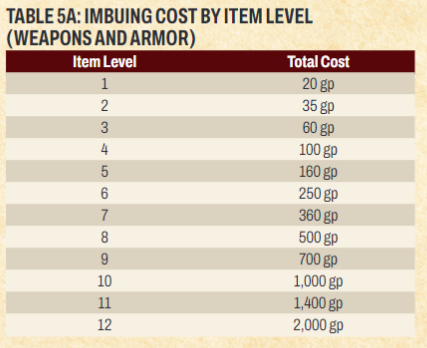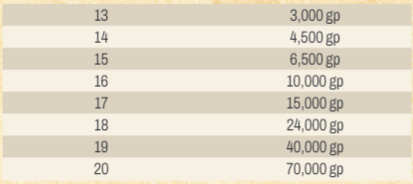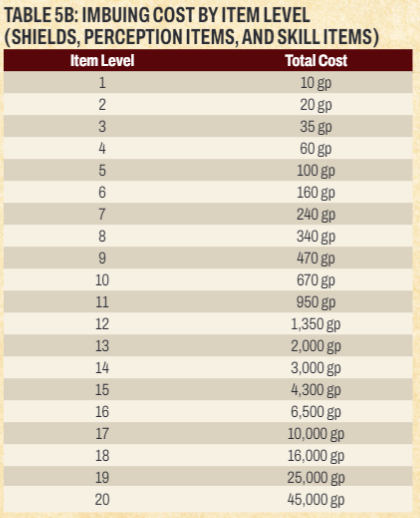Battlezoo_Bestiary_v5.pdf
Gather Suitable Materials §
- Can spend 10 minutes after a battle to gather monster parts. Can also instead spend more time to scavenge more parts (p.135)
- Automatically succeed at this task, no check.
- Parts tend to be very bulky.
- Use Parts quickly so as not to be weighed down long term
- L Bulk for Small
- 1 Bulk for Medium
- 2 Bulk for Large
- 4 Bulk for Huge
- 8 Bulk for Gargantuan
- Include monsters that aren’t sources themselves, but supply refined items to be broken down and used for their own purposes (e.g. weapons or armor with parts attached), or unrefined parts.
- The PCs can keep track of monster parts by their value, as well as the monster that provided them (for instance, “12 gp of giant crab parts”).
- Can split the value of parts as needed.
Allocating the Proper Amounts of Materials §
- Table 1B for Hybrid Variant over Level
- Hybrid Variant per Level
- Table 2B for Hybrid per Encounter, if desired
- Hybrid Variant per Monster
- Gathering More
- Appropriate Lore Skill can forage more from a corpse using Earn Income Downtime Activity - DC equal to Monster Level
- Monster Scavenger Feat
- Trading Monster Parts
- Sell for half listed value if possible.
- May trade for other parts w/ other adventurers
Refining Materials §
- Allows creation of mundane weapons/armor from Monster Items. Use normal cost for item values. Allows for Imbuing of magical properties on those items.
- Shields can use steel shield stats, without steel requirement.
- Allow refinement quickly w/o Downtime. Faster, easier to remember what parts
- Record notable creatures’ names by generally appending it to the item name (e.g. “of the crimson wyrm”).
- Can create:
- Weapons
- Armor
- Shields
- Perception Items
- Skill Items
- Items level up when the total value of parts used reaches a threshold, granting additional benefits
- Can’t refine above your level, but can increase this value towards next level in the meantime, like XP.
- Armor Refinement Costs By Item Level
- Skill Item Refinement Costs by Level
- Salvaging and Transferring
- Can salvage 50% of value’s worth of parts. Like selling w/o need to return to town.
- e.g. Axe w/ 100 gp refined and 100 gp fire parts gives 50 of each variety.
- Can transfer refinement value or Imbuements from an item of the same type (weapon, armor, shield, Perception item, or skill item)
- Choose what to swap (refinement value or value of imbued property)
- Items must have compatible requirements for type of parts needed (i.e. both slashing/ both bludgeoning)
- Provide 10% of the difference in value of the two items in additional monster parts
- Finally, swap the refinement or imbued property
- Refining Items
- Refining Weapons
- Refining Armor
- Refining Shields
- Refining Perception Items
- Refining Skill Items
- Example
- The party’s level 7 fighter recently lost their favorite weapon, and so they want to refine an amazing longsword out of the teeth of the tyrannosaurus they just defeated. They’re playing using the hybrid variant and have 275 gp of tyrannosaurus parts. Although a tyrannosaurus doesn’t have a slashing attack, longswords have the versatile piercing trait, which means the fighter can use the teeth to refine their longsword. They start the refinement by building the tyrannosaurus tooth longsword (0) for 1 gp, and then put the remaining 274 gp into the longsword’s refinement. Next, they refine the sword and spend 250 gp, which means the fighter has refined the longsword to item level 6, and it gains the appropriate benefits: a +1 item bonus to hit, a second weapon damage die, and the ability to imbue an imbued property. The sword is now a +1 striking longsword (6), with 24 gp of monster parts remaining. Finally, the fighter decides they want their longsword to reach level 7 as quickly as possible, so they apply the remaining 24 gp of monster parts to the longsword, which makes the final weapon a +1 striking longsword (6) refined to 274 gp—just 86 gp more of parts for the longsword to reach 7th level! In addition, the fighter is particularly excited about that imbued property, as the group also recently defeated 2 magma scorpions and now they have fiery plans for what comes next for their +1 striking tyrannosaurus tooth longsword (6)
Imbuing §
- Once refined to a high enough level, you are able to imbue them with magical properties. These vary by level. (Tables 4A through 4E)
- Weapons at Level 2, 10, 16
- Armor at Level 5, 11, 18
- Shields at Level 4
- Perception Items at Level 3
- Skill items at Level 3
- Parts need to match the requirements for the imbued property. (e.g. imbuing a cold property needs parts from a monster with at least one cold ability)
- Track the Imbued values separately from Refinement and from each other in case of swapping.
- Continue adding value as you use more parts as with refining.
- Once a threshold has been reached, the Imbued Property levels up, potentially granting new abilites/increased benefits.



- Like with refining, values and benefits are cumulative. Can keep adding value to increase Imbued level further; Imbued Level cannot surpass your own level, or the item’s level, whichever is lower.
- Can choose from several options when Imbuing, as some have multiple upgrade paths.


